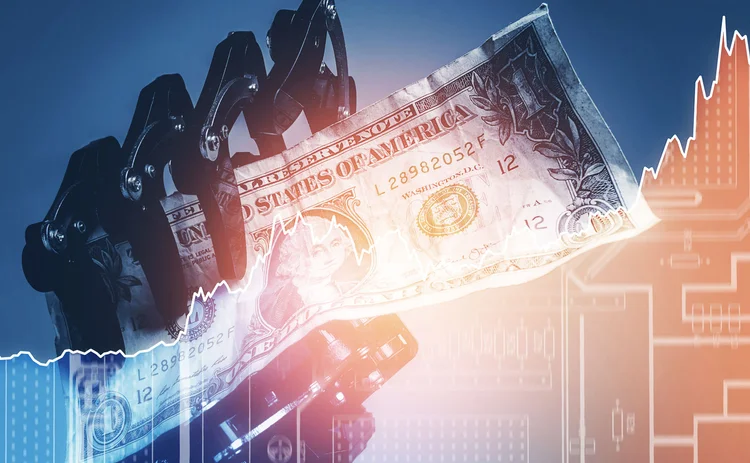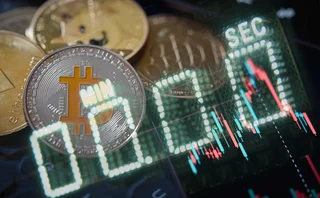How AI can give banks an edge in bond trading
Machine learning expert Terry Benzschawel explains that bots are available to help dealers manage inventory and model markets

In the words of John O’Brien, hedging pioneer and influential academic at the Haas School of Business: “In the future, trading floors will have only computers and a dog. The computers will do the trading and the dog will keep humans from touching the machines.”
This vision of the future is closer than many people imagine, as machine learning and traditional statistical techniques converge to reshape the investment landscape.
Many hedge funds have used algorithmic trading strategies for decades. However, the market-making side of investment banks has lagged investors’ use of AI. For example, dealers have only recently begun to embrace algorithmic applications for market-making and inventory management in corporate bonds.
If banks invest in machine learning tools for their bond trading desks, they can deploy capital more efficiently and develop trading techniques that allow them to decrease bid/ask spreads and compete more effectively with sophisticated clients.
Bond trading flows and bank inventories have a complex relationship. Banks must set aside regulatory capital to offset losses from long or short inventory positions – a requirement that was introduced following the credit crisis of 2008. Default-risky assets like corporate bonds require greater capital charges as there is higher risk of prices gapping lower. Posting collateral is costly for the bank since it cannot deploy the funds for more attractive investments.
If a bank’s inventory is long bonds, then informed traders would adjust their quotes to favour selling to clients; quoting less aggressively on a buy order or more aggressively on a sale. But it’s difficult for traders to be aware of overall exposure in inventory as well as market prices. A machine, though, can easily handle and analyse all the relevant data.
A small number of clients – representing roughly a quarter of trading activity – were directionally correct on 60% or more of their trades over a five-day holding period
Another factor complicating efficient trading is that transactions with certain clients tend to result in losses for the dealer. That is, some clients consistently predict which way markets will move after buying or selling bonds, resulting in dealer losses. Ideally, the market-maker would adjust their quote to account for this – for example, by bidding less aggressively on a bond whose price is more likely to decline. But dealers can only do so if they understand which clients are successfully anticipating price movements.
During my time as a quant in credit trading, I studied the profitability of our clients’ trades. Specifically, I looked at whether clients bought bonds that our model identified as ‘cheap’, or more likely to rise in value, and sold bonds that were ‘rich’, or more likely to fall. The study required a minimum of 1,000 trades for any single client. Surprisingly, a small number of clients – but representing roughly a quarter of trading activity – were directionally correct on 60% or more of their trades when tracked over a five-day holding period. Across the whole client base, if the bank held the opposite position of the client for that day, the client would make money 53% of the time and the bank would lose. The implicit assumption of dealers is that the clients should win or lose on 50% of their trades.
In the study, we input the yield spreads of thousands of individual bonds into algorithms that calculate the bonds’ relative value, determining which are cheap and rich. The study showed that clients, on average, buy bonds that we identified as cheap and sell those that were rich. The purchased bonds had a Z-score of around 0.2 above average, and the sold bonds around -0.2. (Z-scores are a statistical measure of how far data points diverge from the mean. A Z-score of 1 indicates the value is one standard deviation from the average.)
To the extent that some clients systematically “beat the house”, the trading desk must widen its bid/ask spreads to cover that loss. This suggests that bid/ask spreads could be reduced if quotes for market-savvy clients are adjusted to account for the likelihood of dealer loss. The savings would enable the brokers to do more business – and most clients would benefit from tighter spreads.
Finally, as mentioned above, algorithms exist that predict, at least on average, which bonds will increase and decrease in price. Clients, on average, trade in accordance. Those algorithms would give traders advance warning regarding which bonds to buy and sell and how to alter their bid/ask to account for this.
New machine learning tools are becoming available to manage inventory and client performance. The question is whether they will be sufficient to eliminate human market-makers in corporate bond trading.
Terry Benzschawel is the founder and principal of Benzschawel Scientific. He previously headed the portfolio analysis and quantitative strategies group at Citi. Terry is the author of Machine Learning: Origins, Developments and Implications, published by Risk Books.
Only users who have a paid subscription or are part of a corporate subscription are able to print or copy content.
To access these options, along with all other subscription benefits, please contact info@risk.net or view our subscription options here: http://subscriptions.risk.net/subscribe
You are currently unable to print this content. Please contact info@risk.net to find out more.
You are currently unable to copy this content. Please contact info@risk.net to find out more.
Copyright Infopro Digital Limited. All rights reserved.
You may share this content using our article tools. Printing this content is for the sole use of the Authorised User (named subscriber), as outlined in our terms and conditions - https://www.infopro-insight.com/terms-conditions/insight-subscriptions/
If you would like to purchase additional rights please email info@risk.net
Copyright Infopro Digital Limited. All rights reserved.
You may share this content using our article tools. Copying this content is for the sole use of the Authorised User (named subscriber), as outlined in our terms and conditions - https://www.infopro-insight.com/terms-conditions/insight-subscriptions/
If you would like to purchase additional rights please email info@risk.net
More on Comment
Op risk data: Tech glitch gives customers unlimited funds
Also: Payback for slow Paycheck Protection payouts; SEC hits out at AI washing. Data by ORX News
Op risk data: Lloyds lurches over £450m motor finance speed bump
Also: JPM trips up on trade surveillance; Reg Best Interest starts to bite. Data by ORX News
Georgios Skoufis on RFRs, convexity adjustments and Sabr
Bloomberg quant discusses his new approach for calculating convexity adjustments for RFR swaps
In a world of uncleared margin rules, Isda Simm adapts and evolves
A look back at progress and challenges one year on from UMR and Phase 6 implementation
Op risk data: Morgan Stanley clocked in block trading shock
Also: HSBC deposit guarantee gaffe; Caixa hack cracked; reg fine insult to cyber crime injury. Data by ORX News
Digging deeper into deep hedging
Dynamic techniques and gen-AI simulated data can push the limits of deep hedging even further, as derivatives guru John Hull and colleagues explain
Op risk data: US piqued by Pictet tax breach
Also: US Bank’s Covid failings; South Korea’s short-selling clampdown. Data by ORX News
Levelling the playing field for stablecoins
Regulatory asymmetries are a barrier to innovation in digital payments







